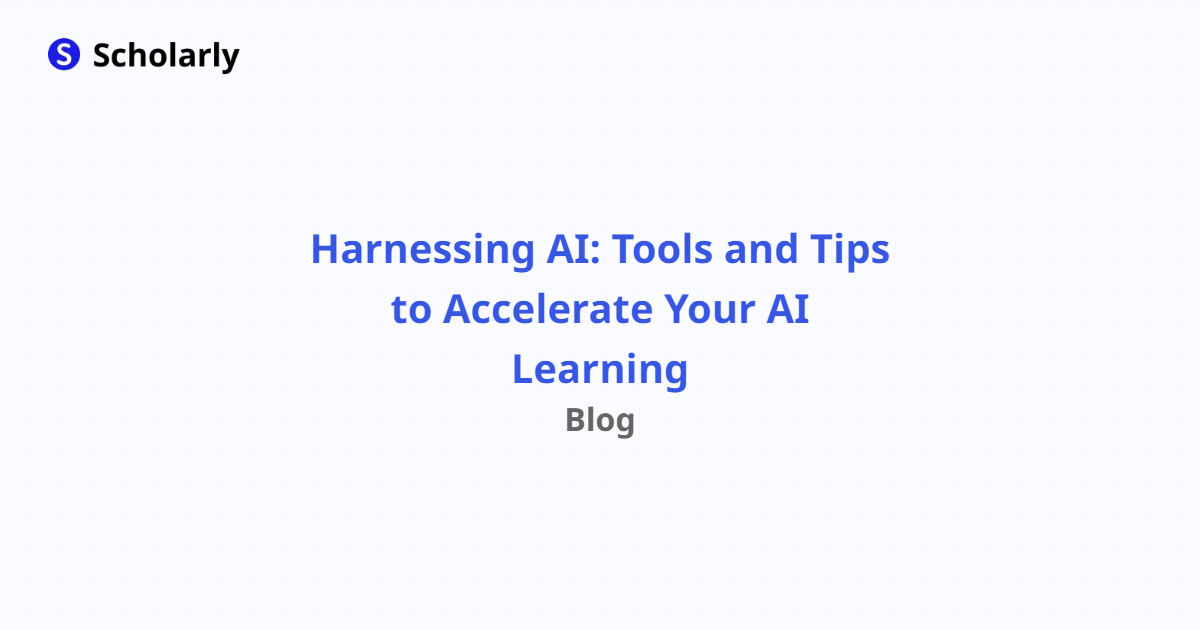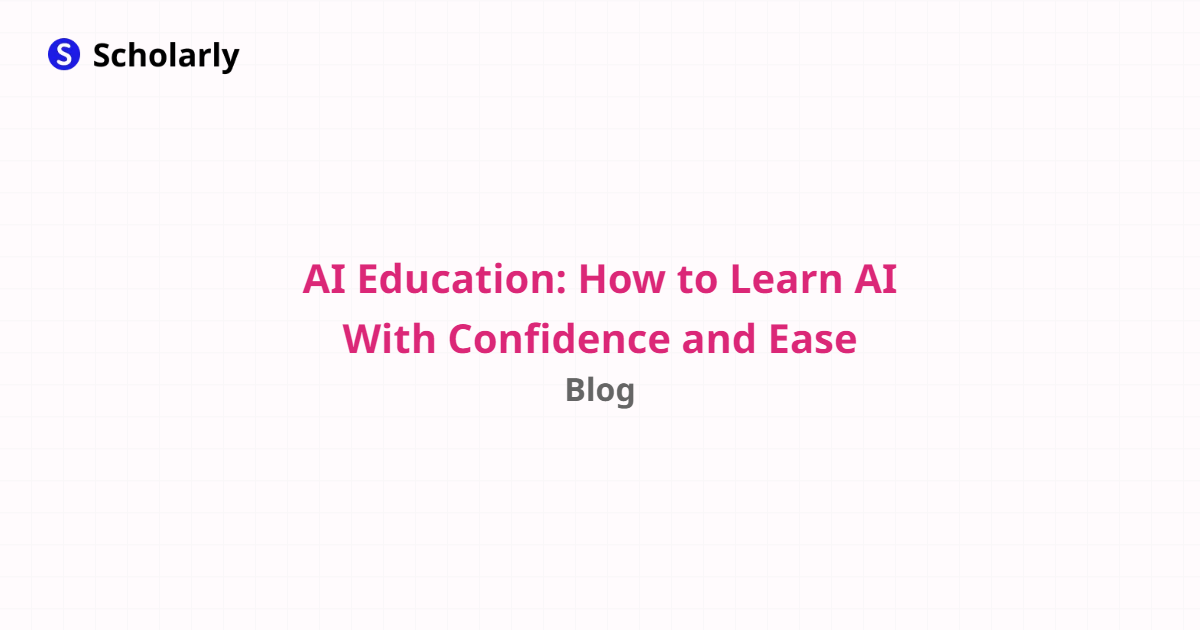Published in General
How Free AI Opens the Door to Advanced Writing Models
By Scholarly
8 minutes read
The integration of artificial intelligence into various fields has been nothing short of transformative, and the domain of writing is no exception. This detailed article unfolds the marvels of Free AI Advanced Writing Models and its implications on the craftsmanship of writing. In a world where content is king, the accessibility of free AI tools is a game-changer for writers everywhere.
Introduction
Writing has always been a discipline where the pen is mightier than the sword. With the advent of AI, the pen has now evolved into an intelligent entity, capable of enhancing our writing abilities beyond conventional boundaries. This blog post will navigate through the history, current innovations, and future prospects of free AI in advanced writing models, discussing its significance, benefits, best practices, and the double-edged sword of its pros and cons. We'll compare various tools and delve into the specifics of the techniques and methods propelled by AI, as well as the challenges faced by users. Additionally, we'll explore potential online applications related to advanced writing models and conclude with a synthesis of all our discussions.
Each subheading in this lengthy post will carry comprehensive insights into the aspect it covers, with meticulous attention to maximizing its SEO potential. By the end of this post, even the uninitiated should feel well-acquainted with the writing revolution heralded by free AI.
History
Past State
Reflecting on the historical landscape of writing, one recalls the era when typewriters clattered and ink filled the pages of countless manuscripts. Before the digital age, writing was largely manual, and the assistance writers could avail themselves of was limited to reference books or editorial feedback, which was often hard to come by and slow to receive. The tools of the past, while valuable for their time, were inherently less efficient and more cumbersome.
Current State
Today, we live in a different reality. Writing aids are at the fingertips of anyone with internet access. Free AI writing assistants, like the ones offered by Scholarly (https://scholarly.so/register), transform the process of content creation. From AI-generated text completion to transcribing pictures and PDFs to text using AI, these modern marvels streamline and enhance the writing experience.
Future State
Looking forward, the writing domain stands on the cusp of an even greater revolution. The integration of AI in writing is bound to become more sophisticated, with tools not only assisting in creation but also helping in ideation, analysis, and even predicting reader response. Applications such as Scholarly will continue to evolve, leveraging AI to the fullest and inspiring new ways of learning, creating, and sharing knowledge.
Benefits
Immeasurable benefits await those who utilize free AI in writing. For instance:
Increased Efficiency: Free AI writing models offer suggestions and completions, enabling writers to produce content faster.
Improved Quality: With AI's assistance in grammar and style, the quality of writing can significantly improve.
Accessibility: Free AI tools open doors for those who may not have access to professional writing aids or editors.
Creative Expansion: AI can suggest unique angles and ideas, broadening a writer's creative horizons.
Educational Assistance: Tools like Scholarly assist in the educational sector, aiding students with AI-generated flashcards and study aids.
Significance
The significance of free AI in advanced writing cannot be overstated. It democratizes the art of writing, allowing individuals from varied backgrounds to express themselves articulately and professionally. It also serves as an educational springboard, particularly when integrated with platforms such as Scholarly, which provide a plethora of AI-driven features for enhanced learning and content creation.
Best Practices
While the advancements are promising, it's critical to engage with AI writing tools effectively. Some best practices include:
Understanding Limitations: Knowing the strengths and weaknesses of AI.
Stay in Command: Use AI suggestions as a starting point, not a crutch.
Regular Updates: Keep the AI tools updated for the latest features and improvements.
Data Privacy: Be mindful of the information shared with AI tools.
Balance with Human Ingenuity: Combine AI assistance with personal creativity.
Pros and Cons
The integration of AI in writing carries a mix of advantages and disadvantages. The pros include augmented writing speed, diversification of thought, and the global reach of quality writing. Conversely, potential cons encompass over-reliance on AI, erosion of personal writing style, and data privacy concerns.
Comparison
When appraising different tools, it's essential to contrast features, accessibility, and user-friendliness. Scholarly, with its comprehensive suite of AI capabilities, contends well with other market offerings.
AI Impact
AI's impact stretches across applications, techniques, benefits, challenges, and online apps. Each facet offers a window into the vast potential AI holds in transforming the writing landscape.
Common Techniques
Various techniques are employed by free AI writing tools, such as predictive text, natural language processing, and sentiment analysis, to name a few. Each technique plays a role in streamlining the writing process and enhancing the quality of the output.
Challenges
Despite the vast promises of AI in writing, challenges persist. These include ensuring the originality of content, dealing with the unpredictability of AI responses, and sustaining the engagement of human readers.
Potential Online Apps that relate to the topic
Numerous online applications are closely associated with advanced writing models. Scholarly (https://scholarly.so/register) is one such platform that marries AI functionalities with educational tools, creating an ecosystem conducive to both learning and writing.
More Subheadings
Explorations into related fields such as the psychological impact of AI on writers, the role of AI in journalistic integrity, future job landscapes for writers in an AI-dominated world, and ethical considerations of AI in literature could be discussed.
Conclusion
In retracing our steps through this vast topic, we have unearthed a treasure trove of knowledge surrounding the use of free AI in advanced writing models. This article has laid bare the historical evolution, projected a vivid picture of the current state, and ventured bold predictions for the future. The benefits have been enumerated, the significance underscored, and best practices outlined. We have navigated through the pros and cons, made comparisons between tools, discussed the impact AI has and will continue to have, uncovered common techniques, looked squarely in the face of challenges, and surveyed potential online applications.
In all, this article serves as a comprehensive guide and primer for anyone keen on understanding and leveraging free AI in the domain of advanced writing models. As content creation continues to reign supreme in the digital age, the intelligent use of advanced AI tools will undoubtedly play an indispensable role in shaping the future of writing.




